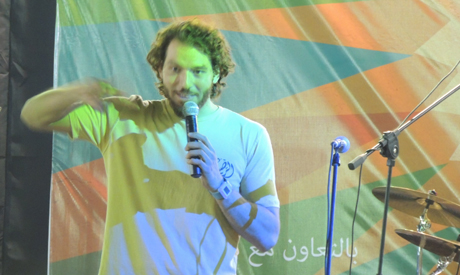
Ahmed Nazmi, Raseef organiser (Photo by Farah Montasser)
Despite its average organisation and unpleasant location the Raseef Festival on Friday and Saturday managed to bring Egyptian and some foreign youth together.
Similar to that of Al-Mawred Al-Thaqafy’s El-Fan Midan iniative, the El-Raseef Festival was also a street art festival located at El-Horreya Square in Maadi.
“The idea behind El-Raseef is to get people together and express our beliefs, ideas and opinions freely,” says Ahmed Nazmi, the festival's head organiser.
“Here we can meet one another and exchange thoughts, visions, and ideas,” he says. “We need to have such open spaces to meet one another instead of each of us working on our own. This is how we can be a productive community and a strong, free force."
El-Raseef ('pavement' in Arabic) featured many concerts by popular Egyptian bands, including Cairokee, Microphone Horr, Percussion Show, Like Jelly, among others. The most cheered for group was Cairokee with its patriotic songs that the youth grew to love, particularly after the January 25 Revolution, including Matloub Zaeem (Leader is Demanded) and Fel Mahata (At The Station).
Nevine Pourcine, a young student at Lycee Francais in Maadi says, "It is the first time I've listened to Cairokee and I'm intrigued."
Mai Said, another attendee, was delighted with the Friday programme: "I really enjoyed my time here. It was a great day and I plan to come tomorrow too."
Besides the bookstore, music and concerts, El-Raseef also featured art exhibitions. One that stood out was by young artist Shaimaa Mohamed Hassan, entitled Mosho Gallery, or this is what she calls her work on her official Facebook page.
To many attendees El-Raseef was more of a street bazaar than an arts festival. Moving onwards vendors surrounded the entire festival area, selling their handmade products of jewellery, oriental weavers, accessories, and glassware, Nubian products and wood crafts, shoes, slippers, clothes, and even plants. All were Egyptian, Islamic, or oriental.
“I very much like and support the concept behind El-Raseef as an open space for young people to express their views and ideas yet I find that the organisation is poor,” says Pourcine.
But to organisers, given the large numbers that attended El-Raseef, their type of festival was a great success.
Short link: